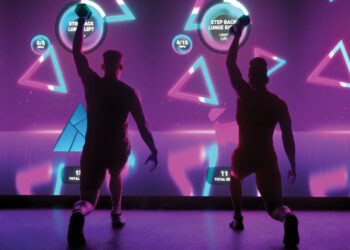 You have questions, we have answers. We took some time this month to speak with Jeff Breit, the general manager of Stafford Hills Club, about how “green” inititiatives and construction helped the club reflect the values of Tualatin, Ore
You have questions, we have answers. We took some time this month to speak with Jeff Breit, the general manager of Stafford Hills Club, about how “green” inititiatives and construction helped the club reflect the values of Tualatin, Ore
“What is a LEED Certification and how does it help your facility?”
JB: Leadership in Environmental and Energy Design (LEED) is an internationally-recognized benchmark for the design, construction and operation of high-performance “green” buildings. LEED is administered by the U.S. Green Building Council. Stafford Hills Club (SHC) has been designed and built to meet the requirements of LEED 2009 for New Construction & Major Renovations certification at the Silver level.
We believe that a LEED-certified business demonstrates not only a value on doing what is right for the environment, but it is also good business. Our facility will run more cost effectively as a result of these LEED efficiencies and, in turn, allow us to redirect those expenses toward programs and services that can improve the day-to-day member experience.
“How does being ‘green’ benefit your members?”
JB: In the development of SHC we researched the world and examined the best practices of the industry. We took that knowledge and combined it with the unique values of our community, to develop a place that could grow in partnership with our members, and in synergy with their values over time. The LEED certification demonstrates our desire to provide a place where like-minded people can improve their lives together. Being “green” is a partnership in values with our members, the community and our staff.
“Financially, how does being ‘green’ benefit your club?”
JB: Financially the LEED certification makes sense for our business on several levels:
- Operational Efficiency — our design is anticipated to reduce key utility costs in excess of 30 percent over less efficient systems. For example, our seven indoor tennis courts take advantage of a state-of-the-art airflow design that allows us to avoid the need for any built-in heating and cooling equipment. It utilizes exterior air ventilation along with large glass windows that provide inherent solar heat to keep the space comfortable during the various season changes we encounter in the Pacific Northwest.
- Incentives — Our LEED Silver certification will qualify us for an excess of $100,000 in various local, state and federal tax incentives and grants.
- Marketing and Membership Sales — The LEED status sets us apart from many of our competitors.
- Retention — We believe that members who feel connected to the values of their club will remain members longer, thus improving retention.
“How do you work with your members to extend the ‘green’ movement?”
JB: In the coming weeks, months and years, Stafford Hills Club will impact the lives of thousands of people. Whether we are helping educate someone on healthy cooking, motivating them through a workout, or doing a youth art class focused on a “green” theme, we believe that the experiences around “wellness” that our members learn here will provide a foundation for them to share with others.
How Stafford Hills Club Achieved LEED Certification
- Energy Efficiency: High Performance, Energy-Efficient Design.
- Renewable Energy: Solar Thermal Water Heating.
- Water Efficiency: Water-efficient Plumbing Fixtures.
- Natural Habitat & Open Space: Wetland Restoration.
- Healthy Indoor Air Quality: Low-Emitting Building Materials.
Additional Insights
The following are examples of areas of focus Stafford Hills has developed into its design and operations to achieve this certification:
- Energy Efficiency: High-performance, Energy-efficient Design – Through a strategic combination of good energy design and selection of energy-efficient lighting, heating and hot water equipment, SHC is forecasted to use approximately 20 percent less energy each year compared to a comparable code-built building.
- Renewable Energy: Solar Thermal Water Heating – The SHC swimming pool is equipped with a roof-top solar water heating system, expected to produce 3 percent of SHC’s overall annual energy load.
- Water Efficiency: Water Efficient Plumbing Fixtures – Equipped throughout with a set of water-efficient plumbing fixtures – 1.27 gallon toilets, 0.5 urinals, low-flow 1.5 gallon per minute showerheads and low-flow lavatory faucets – SHC is expected to use about 37 percent less water than a comparable club with standard plumbing fixtures.
- Natural Habitat & Open Space: Wetland Restoration – The 450,000-square-foot natural wetland area adjacent to SHC has been protected and restored through the planting of hundreds of trees, shrubs and grasses, most of which are native to the Willamette Valley. The wetlands offer fish and wildlife habitat, floodwater storage capacity, scenic views and recreational opportunities.
- Healthy Indoor Air Quality: Low-emitting Building Materials – Many of the building products used throughout SHC were specifically chosen in part for their no- or low-VOC content. These materials include: adhesives, sealants, paints, coatings, flooring systems and composite woods. VOCs are volatile organic compounds which off-gas at room temperature and can be odorous, irritating and harmful to occupants’ health and well-being. These low-emitting products contribute to a healthy indoor environment.
Stay ahead in the fitness industry with exclusive updates!
Rachel Zabonick-Chonko is the editor-in-chief of Club Solutions Magazine. She can be reached at rachel@peakemedia.com.











